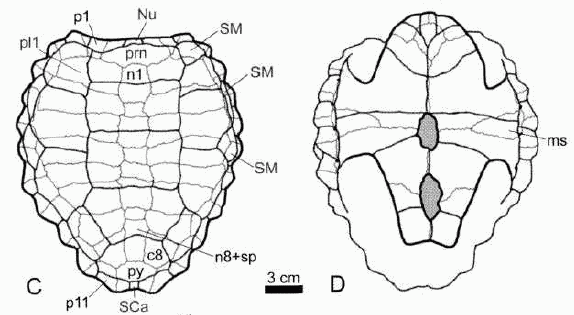
Platychelys oberndorferi, Late Jurassic of Germany. Shell in Dorsal (left) and Ventral (right) view. Drawing from Böhme, 2005, p.352.
| Chelonii | ||
| The Vertebrates | Pleurodira |
| Vertebrates Home | Vertebrate | Vertebrate |
|
Abbreviated Dendrogram
Anapsida ?
│
└─○Chelonii
├─Odontochelys
└─┬─Proganochelys
└─┬─Proterochersis
└─┬─Meiolanoidea
└─┬─○Pleurodira
│ ├─Platychelys
│ ├─Dortokidae
│ └─┬─Chelidae
│ └─Pelomedusoidea
│ ├─Podocnemoidae
│ │ ├─Bothremyidae
│ │ └─Podocnemidae
│ └─Pelomedusidae
├─Paracryptodira
└─○Eucryptodira
├─Protostegidae
╘═╤═Xinjiangchelyidae
╘═╤═Sinemydidae
├─Trionychoidea
└─┬─┬─Chelonioidea
│ ├─Chelydridae
│ └─Kinosternoidea
└─Testudinoidea
|
Contents
Overview |
Taxa on This Page
Pleurodira (= Panpleurodira of Joyce et al 2004)
from Late Triassic (Gaffney, 1975, Shaffer, 2009) or Late Jurassic (Joyce 2007, Anquetin, 2009)
Parent clades: a choice of options:
Pantestudines : Casichelyidia : Cryptodira + * : Proterochersis + (Eupleurodira : Daughter clades) (Gaffney, 1975)
Pantestudines : (assorted stem forms) : Cryptodira + * : Daughter clades (Joyce 2007, Sterli, 2008, Anquetin et al. 2009)
Pantestudines : (assorted stem forms) : Paracryptodira + (Eucryptodira : Xinjiangchelyidae + (Cryptodira + * : Daughter clades). (Anquetin, 2009) (inspired by Krenz et al 2005, Danilov & Parham, 2006, and Anquetin, 2009),
Daughter clades: Platychelys ::: Chelidae + Pelomedusoidea.
Skull roof not complete; $ no epipterygoid (not even cartilage); $ major jaw adductor passes over enlarged lateral trochlear process of pterygoid; retracted neck is S-shaped horizontally; neck retraction by ball-and-socket joints; cervical postzygapophyses closed or fused; $ fusion of all pelvic elements to shells (ilium fused to carapace; pubis & ischium to plastron); sacrum may involve up to 4 vertebrae (2 in cryptodires). Now S hemisphere only; dominant in Aus; formerly world-wide (until Cz). Almost all fresh water species.
Links: Anapsida -- The Dinosauricon (cladogram); Animal Fact Sheets; Pleurodira; PLEURODIRA; Order Testudines; Higher Reptile Taxa; Yahoo! Groups : Pleurodira; Dr. Christian Beisser; ETI - Turtles of the World: Classification; histo Spanish); DigiMorph - Elseya dentata (and related pages); Phylogeny of Turtles/Dr. E. S. Gaffney (Best on the Web); I. ¿qué tan viejas son las tortugas? (Spanish).
Discussion: One startlingly odd thing about turtle phylogeny is the ability of all turtles, except clearly derived specialists, to withdraw the head inside the carapace. This appears to be a unique ability, but not a synapomorphy, i.e. not a shared derived character. Pleurodires diverged from cryptodires perhaps as early as the late Triassic (perhaps 220 My), and certainly by the late Jurassic (150 My). However, no turtle is known to have possessed the specializations needed to withdraw the head into the carapace until the Cretaceous (roughly 100My), at which point both major turtle lineages developed the same ability using quite different biomechanical strategies. In fact, there is enough variation among the methods used by Cryptodires that the ability may have developed more than twice, entirely independently.
On its face, this is a bizarre set of facts. Why would two separate lineages develop the same strategy at roughly the same time, long after the two had diverged? It is not particularly strange that both groups would develop the ability to withdraw the head. Turtle morphology is quite conservative and, even after 50-100 My, all turtles had a great deal in common. But what conceivable selective pressure would emerge for the first time in the Cretaceous to force both lineages to develop the same strategy and eliminate virtually all turtles which could not adapt in this unique fashion?
There are a number of possible speculative answers -- bird predation comes to mind, for example. However, turtles cover a good many ecological roles in a wide variety of environments, both terrestrial and marine. Any explanation must apply to all of these cases.
References: ES Gaffney (1975), Bull. Am. Mus. Nat. Hist. 155:387-436. Basic changes in skull morphology may have occurred prior to pleurodire- cryptodire split. ES Gaffney & JW Kitching (1994) Nature 369:55. ATW 020225.
Note: The above comments are based on the phylogeny of Gaffney, 1975, according to whom Proterochersis was the first pleurodire. If the latter is not included, then Eupleurodira ((Characters: cervical centra not amphiplatyan. Link: Pleurodira 020202.) is synonymised with Pleurodira
 Platychelys oberndorferi, Late Jurassic of Germany. Shell in Dorsal (left) and Ventral (right) view. Drawing from Böhme, 2005, p.352. |
Platychelys: Platychelys oberndorferi Wagner, 1853
Pleurodira : * + Dortokidae + (Chelidae + Pelomedusoidea)
Late Jurassic of Bavaria, France, and England. (Zittel, Eastman, et al (1902), p.207
Characters: "Carapace somewhat depressed, with a number of more or less distinct ridges or prominences on the neurals and costals. Neurals short and of irregular contour, the width usually much exceeding the length. Bridge short. Mesoplastrals not meeting in the middle line. Vertebral shields much wider than long ; nuchal shield present; intergular undivided. No articulation between pelvis and plastron (Lydekker)".(Zittel, Eastman, et al (1902), p.207)
Comments: Platychelys oberndorferi is the only species in F amily P latychelyidae Bräm, 1965. Possibly the basalmost (Joyce 2007, p.62) (most primitive or least specialised) of three fossil taxa currently situated along the pleurodire phylogenetic stem, hence "panpleurodira" sensu Joyce et al 2004, the other two being Caribemys oxfordiensis from the Late Jurassic of Cuba, and Notoemys laticentralis from the Late Jurassic of Argentina. Platychelys was first described from lithographic shales near Kehlheim, southern Germany, but is better known from the shallow marine limestones quarried near Solothurn, Switzerland (also known as the Solothurn 'turtle-limestone' or 'Schildkrötenkalk'). A comparitively rare fossil, it is thought to have been a freshwater turtle that inhabited fluvial systems, swamps and lakes of near-shore environments, whereas other taxa from the Solothurn limestone more likely lived in the near-shore marine environments. (Scheyer 2007, p.46)
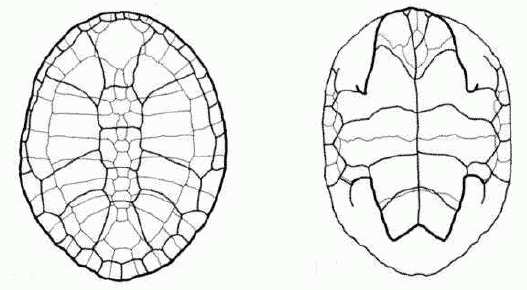 Dortoka vasconica, Late Cretaceous of Europe. Shell in Dorsal (left) and Ventral (right) view, length about 18 cm. Drawing from Böhme, 2005, p.352. |
Pleurodira : Platychelys + (Chelidae + Pelomedusoidea) + *
Late Cretaceous to Early Eocene of Europe
Comments: includes two genera: Dortoka Lapparent de Broin and Murelaga, 1996 from the Late Cretaceous of Spain and France (shell upto 18 cm) and Ronella Lapparent de Broin et al from the late Paleocene or early Eocene of Romania (shell greater than 25 cm). Less complete finds also known from the Early Cretaceous of Spain. Probably lived a lifestyle similar to taht of the extant African genus Pelomedusa. Feature a combination of primitive and derived characters. Variously considered ancestral to the Pelomedusoides or more closely related to Platychelys, outside the Eupleurodira. (Böhme, 2005 p.354.)
Pleurodira : Platychelys ::: Chelidae + *: Pelomedusidae + Podocnemoidae.
See Pelomedusidae.
ATW030416.
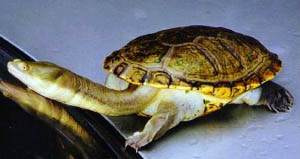 Chelidae Gray, 1831 :
Chelodina, Emydura, Elseya (all Aus), Platemys, Hydromedusa, Phrynops (all S.Am.). Small to medium-sized "snake-neck" aquatic turtles of Aus & S. Am.
Chelidae Gray, 1831 :
Chelodina, Emydura, Elseya (all Aus), Platemys, Hydromedusa, Phrynops (all S.Am.). Small to medium-sized "snake-neck" aquatic turtles of Aus & S. Am.
from the Late Cretaceous of Australia, New Guinea, & South America.
Pleurodira : Platychelys ::: Pelomedusoidea + *.
Characters: Quadratojugal absent; cheek emargination from ventral margin of skull, extending more posteromedially than in any other turtle group; unique arrangement of the articulations among the neck vertebrae, cervical centra five and eight are convex, mesoplastron absent; intergular (extra scute on plastron) present; extremely long necked ambush predators of fish, or shorter-necked molluscovores with typical durophagous dental specializations.
Comments: 52 living species grouped into 15 genera, of Australasian and South American Side-Necked or Snake-Necked Turtles (so called because of the very long neck, e.g. the Australian Chelodina longicollis (Wikipedia page)). Aquatic or semiaquatic prefer slow-moving streams and swamps. They are carnivores that take a broad range of aquatic prey. Chelus fimbriatus the South American mata mata (Chelus fimbriatus; Wikipedia page) has flaps of skin which, along with the strikingly Proganochelys-like shell shell which resembles a piece of bark, and the head which resembles fallen leaves, and the growth of algae, help conceal the animal.
Until recently, the fossil record was very poor and restricted to the Tertiary, but recent South American finds, similar to the recent Chelus fimbriatus, Hydromedusa, and Phrynops, extend the range back to the Late Cretaceous. Older specimens probably represent basal panchelids (stem taxa) (Joyce et al 2004 p.999).
Links: infoplease; Turtle, Tuatara, Crocodile Checklist--13; Chelidae; THE TURTLE GALLERY; Turtle, Tuatara, Crocodile Checklist--Literature Cited; CTTC - Matamata, Chelus fimbriatus by William H. Espenshade; Testudo hermanni site. Chelidae; chelidae Japanese); ETI Turtles Info - Temperature-dependent sex determination; Molecular Evidence for Higher Relationships Among Turtles; DGHT-AG Schildkröten: Arbeitskreise (Deutsch); Mag. Christian Beisser (surprisingly cool research!); pintroduction Français); side-necked turtle. The Columbia Encyclopedia; ????????? Chinese); WWW.chelidae.COM / home; ??????? chelidae (Japanese, I think); Chelidae, Schlangenhalsschildkröten (German); Familie Chelidae, Schlangenhalsschildkröten: Bilder (German); familia Chelidae; Testudo hermanni site; Digimorph - Elseya dentata (northern snapping turtle); tierdach.de: Halswender-Schildkröten (German); Digimorph - Chelus fimbriatus (mata mata); pintroduction French); Turtles and Tortoises; CTTC - Matamata, Chelus fimbriatus by William H. Espenshade; ??? - ??????? Chelodina longicollis (Chinese).
Image: Chelodina novaguinea, courtesy Darrell Senneke of the Tortoise Trust, USA. ATW020910.
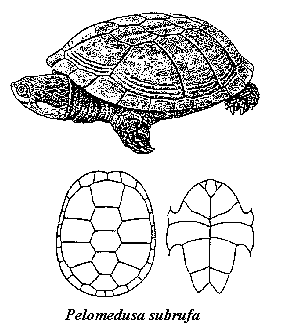 Pelomedusidae Cope, 1868 :
Pelomedusa, Pelusios, Platycheloides, Teneremys. Medium to large FW aquatic turtles from Africa and South America. Defined polyphyletically as all living pelomedusoids.
Pelomedusidae Cope, 1868 :
Pelomedusa, Pelusios, Platycheloides, Teneremys. Medium to large FW aquatic turtles from Africa and South America. Defined polyphyletically as all living pelomedusoids.
Range: from the Early Cretaceous.
Phylogeny: Pelomedusoidea: Podocnemoidae + *.
Characters: $ frontals have transverse anterior margin rather than projecting anteriorly between the prefrontals; $ quadrate completely surrounds stapes; quadrate does not contact basioccipital; carotid enters the skull through the prootic; $ posterior pleurals meet on midline between neurals & suprapygal.
Comments: The African and South American sideneck turtles; 2 genera and eighteen extant species. Most fossils currently attributed to this clade exhibit few diagnostic characters. The fossil record of crown Pelomedusidae extends at least to the Miocene. the most basal form is Teneremys lapparenti from the Aptian of Niger (Joyce et al 2004, p.999)
Links: Pelomedusidae; Turtle, Tuatara, Crocodile Checklist--15; Summary sequence view; Zardoya, R & A Meyer (1998); UTDMG - Pelusios sinuatus; Pelomedusidae; CTTC - Matamata, Chelus fimbriatus by William H. Espenshade; Pelomedusidae Spanish); pelomedusidae Japanese); ETI Turtles Info - Pelomedusa subrufa example; side-necked turtle. The Columbia Encyclopedia, Sixth Edition. 2001; Schildkröten German); pelomedusidae, pelomedusenschildkröten, reptilien, reptilia (German); ??????? pelomedusidae (Japanese); Digimorph - Pelusios sinuatus (East African serrated mud turtle); Testudo hermanni site (Italian); pintroduction French).
Image: Pelomedusa: Swiss Federal Veterinary Office regulations § 820.112.46(1). ATW020802.
fr up(?)K.
Splenial absent(?); nasals absent; $ quadrate contacts basioccipital; parietal & jugal in contact; post-otic antrum small or moderate; cervical centra generally biconvex; cervical scute absent; mesoplastra reduced and lateral; neural series on carapace not complete, interrupted by costals; pectoral scutes usually contact entoplastron.
Comments: African and South American Side-Necked Turtles. Generally oomnivores. Current forms limited to Africa , Madagascar , and South America , but were more widespread .
Links: Pleurodira; Araripemys barretoi. photo - Araripemys - wiki commens
References: Gaffney & Meylan (1988); Meylan (1996).
Note: This is the clade that unites the extant podocnemids with the Cretaceous bothremyids. The original cladogram of Gaffney & Meylan (1988) described the bothremyds as the sister group of living pelomedusids, and united the two based on the occipital condyle being formed only by the exoccipitals (that is, the basioccipitals were excluded from the condyle). Meylan (1996) reanalyzed the data with the inclusion of new material from very basal pelomedusoids and determined that the bothremyds were, instead, intermediate between the pelomedusids and podocnemids. Given the extensive re-engineering of neck joints in all turtles in the late Cretaceous, it makes good sense to suspect that podocnemids secondarily re-integrated the basioccipitals with the occipital condyle at about that time, when they diverged from the bothremyd stock. 011109.
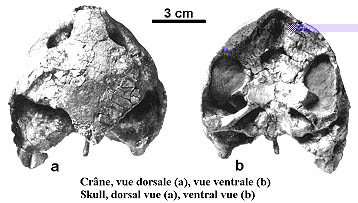
Bothremyidae: Bothremys, Foxemys, Polysternon, Rosasia, Taphrosphys
Range: Late Cretaceous to Miocene. Cosmopolitan.
Podocnemoidae: Podocnemidae + *.
Characters: $ stapedial canal open anteriorly; $ eustachian tube separated from columellar notch; $ quadrato-basisphenoid covers prootic in ventral view; marine & fresh water.
Comments: a group of widely distributed fossil chelonian taxa that frequented near-shore environments, while some taxa like "Foxemys cf. F. mechinorum" inhabited fluvial or lacustrine environments (Scheyer 2007, p.46)
Museé.Dinosaures - les Collections (in French. English at MuséeDinosaures - Types; Chéloniens in French); Pleurodires- research in progress (Best on the Web).
Image: Foxemys Late Cretaceous of France, from Museé. Dinosaures - les Collections.
Notes: There are a completely unreasonable number of excellent web resources for such an obscure taxon. 011001.
Podocnemidae: Gray, 1869 (=Podcnemidae): Erymnochelys, Neochelys, Peltocephalus, Podocnemis.
Range: Fresh water turtles from South America. Probably originated in the Late Cretaceous.
Podocnemoidae: Bothremyidae + *.
Carotid canal greatly enlarged, forming large channel; large pterygoid flange extends posteromedially covering prootic.
Comments: Eight living species grouped into three genera currently recognized, includes a number of South American and African taxa such as the Madagascan Big-headed, Big-headed Amazon River Turtle and South American sideneck river turtles. The gigantic Late miocene/Early Pliocene Stupendemys geographicus, the largest chelonian known, is included in Podocnemidae based on morphological characters of the postcranium, especially on the saddle-shaped central articulations of the cervicals. (Scheyer 2007, p.48). The group goes back to the Middle Cretaceous, if the basal forms ("Panpodocnemidae") Brasilemys josai (Lapparent de Broin, 2000b) and Cearachelys placidoi (Gaffney et al., 2001) from the Albian of Brazil, are included (Joyce et al 2004 p.999).
Links: Pleurodira; Podocnemidae; Untitled Document. ATW010518.
checked ATW030416. Page last modified MAK110922. All material by ATW is public domain and may be freely used in any way (also any material jointly written by ATW and MAK). All material by MAK is licensed Creative Commons Attribution License Version 3.0, and may be freely used provided acknowedgement is given. All Wikipedia material is either Gnu Open Source or Creative Commons (see original Wikipedia page for details). Other graphics are copyright their respective owners